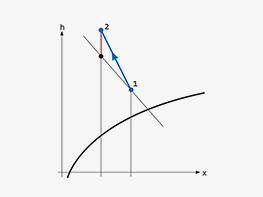
Humidification Made Simple:
How does a Desiccant Dryer work?
Definition
A desiccant dryer is a dehumidifier that uses the properties of a hygroscopic material, known as the sorbent, to draw water vapor from the air.Desiccant dryer operation
The hygroscopic material draws in moisture, thereby drying the air stream. This part of the process is called the adsorption process. To force the accumulated moisture back out of the sorbent, hot air is then forced through the adsorption medium in the opposite direction, and the water vapor trapped by the adsorption medium is taken up by the hot air stream. This process of desorption is known as regeneration.In a desiccant dryer, the sorption material usually consists of a highly hygroscopic silica gel firmly embedded in a slowly turning rotor which turns continuously between two separated air streams flowing in opposite directions. The humid air stream is dried in the rotor’s adsorption area. In the regeneration area, the moisture stored in the sorption material is forced out and taken up by the hot air stream. Since the functioning of this system is based on sorption, which is a largely temperature-independent process and does not depend on condensation, desiccant dryers are especially advisable for low-temperature conditions. Desiccant dryers can also achieve exceptionally low humidity levels, such as those required in the pharmaceutical industry.
Areas of Application
Unlike condensation dehumidifiers, whose area of application is limited by the system limits of the respective cooling circuit being used, desiccant dryers are not subject to any limitations with respect to temperature and humidity. However, due to the system, their specific power consumption is always higher than that of any condensation dehumidifier. They should therefore be deployed where particularly low supply air humidity levels (< 6 g/kg) or low ambient temperatures justify increased energy consumption or where condensation dehumidifiers are no longer adequate for the dehumidification task. The following diagram by Thiekötter presents a rough comparison from the viewpoint of specific power consumption between condensation dehumidifiers operated using coolants and desiccant dryers with purely electrically operated regeneration.Connection
The different air currents of the desiccant dryer must be conducted through ventilation ducts. This is generally carried out using spiral ducts. The humid air duct going outside should be insulated. If external air is used as process air, care must be taken to ensure that the humid air outlet is sufficiently far away from the external air outlet. The humid air must always be conducted outwards.Regeneration and temperature control
In order to force out and discharge adsorbent water vapor bound in the rotor, the adhesive powers operating on the surface of the sorbent must be removed. To do this, the regeneration air stream must be heated accordingly. This is carried out by means of an upstream regeneration heater. With smaller desiccant dryers, the regeneration heating is always carried out using electricity. In the case of larger aggregates, the regeneration heater can be operated as follows:Larger desiccant dryers feature the possibility of using various media for regeneration of the rotor. If possible, for the purposes of maximum energy efficiency, on-site media such as steam, hot water or PWW warm water should be used for or to support the regeneration..
The storage material of the rotor is heated through the application of the rotor with high temperatures around 120°C to force out the adsorbent water vapor bound in the rotor. The change of state of the drying sector therefore is not ideally carried out through an adiabatic process at constant enthalpy. The remaining heat in the rotor is designated stored heat and leads to overheating of the dry air flow by approx. 1.5 K per g/kg of drying performance. In the case of an assumed stored heat of 1.3 K/g/kg, this overheating amounts, e.g. in a drying process of 12, to 4.5 g/kg dry air: 1.3 K/g/kg x (12 – 4.5)g/kg = 9.75 K.
Knowledge of this fact is important for the assessment of the integration of a desiccant dryer into the overall air conditioning strategy of the area to be dried. In the manufacturer’s technical calculations, the stored heat is already taken into consideration and the actual temperature of the dry air stream is stated.
To reach especially low supply air humidity levels, surface coolers must be installed upstream if necessary. In temperature-sensitive areas, the supply air temperature must be regulated directly via the dryer by means of an aftercooler, as necessary in combination with a post-heating pack. Ideally, the manufacturer of the desiccant dryer should deliver the required modules, ready to be connected, built-in to the dryer housing. When untreated external air is being dried, a pre-heater should be provided for protection from frost.
